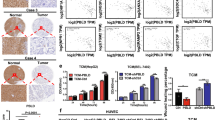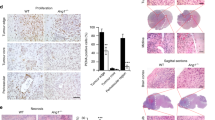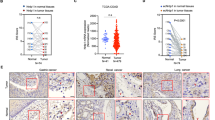Abstract
Angiogenesis, which is the process of sprouting of new blood vessels from pre-existing vessels, is vital for tumor progression. Proteolytic remodeling of extracellular matrix is a key event in vessel sprouting during angiogenesis. Urokinase type plasminogen activator receptor (uPAR) and cathepsin B are both known to be overexpressed and implicated in tumor angiogenesis. In the present study, we observed that knockdown of uPAR and cathepsin B using puPAR (pU), pCathepsin B (pC), and a bicistronic construct of uPAR and cathepsin B (pCU) caused significant inhibition of angiogenesis by disrupting the janus kinase/signal transducer and activator of transcription (JAK/STAT) pathway-dependent expression of vascular endothelial growth factor (VEGF). Further, transcriptional suppression of uPAR and cathepsin B inhibited tumor-induced migration, proliferation of endothelial cells and decreased tumor-promoted expression of VEGF receptor-2, Rac1, gp91phox, cyclin D1, cyclin dependent kinase 4 and p-Rb in human dermal microvascular endothelial cell. Furthermore, U251 and SNB19 xenograft tissue sections from nude mice treated with pCU showed reduced expression of VEGF and CD31, which is a blood vessel visualization marker. Overall, results revealed that knockdown of uPAR and cathepsin B inhibited tumor-induced angiogenesis by disrupting the JAK/STAT pathway-dependent expression of VEGF. These data provide new insight in characterizing the pathways involved in the angiogenic cascade and for the identification of novel target proteins for use in therapeutic intervention for gliomas.
This is a preview of subscription content, access via your institution
Access options
Subscribe to this journal
Receive 12 print issues and online access
$259.00 per year
only $21.58 per issue
Buy this article
- Purchase on Springer Link
- Instant access to full article PDF
Prices may be subject to local taxes which are calculated during checkout







Similar content being viewed by others
Abbreviations
- HMEC:
-
human dermal microvascular endothelial cell
- JAK:
-
janus kinase
- PBS:
-
phosphate-buffered saline
- STAT:
-
signal transducer and activator of transcription
- uPAR:
-
urokinase-type plasminogen activator receptor
- VEGF:
-
vascular endothelial growth factor
- NADPH:
-
nicotinamide adenine dinucleotide phosphate
References
Carmeliet P, Jain RK . Angiogenesis in cancer and other diseases. Nature 2000; 407: 249–257.
Bello L, Giussani C, Carrabba G, Pluderi M, Costa F, Bikfalvi A . Angiogenesis and invasion in gliomas. Cancer Treat Res 2004; 117: 263–284.
Carmeliet P . Angiogenesis in health and disease. Nat Med 2003; 9: 653–660.
Kalluri R . Basement membranes: structure, assembly and role in tumour angiogenesis. Nat Rev Cancer 2003; 3: 422–433.
Lakka SS, Gondi CS, Rao JS . Proteases and glioma angiogenesis. Brain Pathol 2005; 15: 327–341.
Chamberlain MC, Raizer J . Antiangiogenic therapy for high-grade gliomas. CNS Neurol Disord Drug Targets 2009; 8: 184–194.
Folkman J . What is the evidence that tumors are angiogenesis dependent? J Natl Cancer Inst 1990; 82: 4–6.
Mohanam S, Sawaya R, McCutcheon I, Ali-Osman F, Boyd D, Rao JS . Modulation of in vitro invasion of human glioblastoma cells by urokinase-type plasminogen activator receptor antibody. Cancer Res 1993; 53: 4143–4147.
Yamamoto M, Sawaya R, Mohanam S, Bindal AK, Bruner JM, Oka K et al. Expression and localization of urokinase-type plasminogen activator in human astrocytomas in vivo. Cancer Res 1994; 54: 3656–3661.
Gladson CL, Pijuan-Thompson V, Olman MA, Gillespie GY, Yacoub IZ . Up-regulation of urokinase and urokinase receptor genes in malignant astrocytoma. Am J Pathol 1995; 146: 1150–1160.
Sivaparvathi M, Sawaya R, Wang SW, Rayford A, Yamamoto M, Liotta LA et al. Overexpression and localization of cathepsin B during the progression of human gliomas. Clin Exp Metastasis 1995; 13: 49–56.
Pepper MS . Extracellular proteolysis and angiogenesis. Thromb Haemost 2001; 86: 346–355.
Mai J, Sameni M, Mikkelsen T, Sloane BF . Degradation of extracellular matrix protein tenascin-C by cathepsin B: an interaction involved in the progression of gliomas. Biol Chem 2002; 383: 1407–1413.
Buck MR, Karustis DG, Day NA, Honn KV, Sloane BF . Degradation of extracellular-matrix proteins by human cathepsin B from normal and tumour tissues. Biochem J 1992; 282: 273–278.
Im E, Venkatakrishnan A, Kazlauskas A . Cathepsin B regulates the intrinsic angiogenic threshold of endothelial cells. Mol Biol Cell 2005; 16: 3488–3500.
Premzl A, Turk V, Kos J . Intracellular proteolytic activity of cathepsin B is associated with capillary-like tube formation by endothelial cells in vitro. J Cell Biochem 2006; 97: 1230–1240.
Mazar AP . The urokinase plasminogen activator receptor (uPAR) as a target for the diagnosis and therapy of cancer. Anticancer Drugs 2001; 12: 387–400.
Chapman HA, Wei Y, Simon DI, Waltz DA . Role of urokinase receptor and caveolin in regulation of integrin signaling. Thromb Haemost 1999; 82: 291–297.
Preissner KT, Kanse SM, May AE . Urokinase receptor: a molecular organizer in cellular communication. Curr Opin Cell Biol 2000; 12: 621–628.
Andreasen PA, Egelund R, Petersen HH . The plasminogen activation system in tumor growth, invasion, and metastasis. Cell Mol Life Sci 2000; 57: 25–40.
Mazar AP, Henkin J, Goldfarb RH . The urokinase plasminogen activator system in cancer: implications for tumor angiogenesis and metastasis. Angiogenesis 1999; 3: 15–32.
Obermajer N, Jevnikar Z, Doljak B, Kos J . Role of cysteine cathepsins in matrix degradation and cell signalling. Connect Tissue Res 2008; 49: 193–196.
Busso N, Masur SK, Lazega D, Waxman S, Ossowski L . Induction of cell migration by pro-urokinase binding to its receptor: possible mechanism for signal transduction in human epithelial cells. J Cell Biol 1994; 126: 259–270.
Dumler I, Petri T, Schleuning WD . Induction of c-fos gene expression by urokinase-type plasminogen activator in human ovarian cancer cells. FEBS Lett 1994; 343: 103–106.
Bohuslav J, Horejsi V, Hansmann C, Stockl J, Weidle UH, Majdic O et al. Urokinase plasminogen activator receptor, beta 2-integrins, and Src-kinases within a single receptor complex of human monocytes. J Exp Med 1995; 181: 1381–1390.
Resnati M, Guttinger M, Valcamonica S, Sidenius N, Blasi F, Fazioli F . Proteolytic cleavage of the urokinase receptor substitutes for the agonist-induced chemotactic effect. EMBO J 1996; 15: 1572–1582.
Gondi CS, Rao JS . Therapeutic potential of siRNA-mediated targeting of urokinase plasminogen activator, its receptor, and matrix metalloproteinases. In: Sioud M (ed). siRNA and miRNA Gene Silencing: From Bench to Bedside. Humana Press: Springer, 2008, pp 267–281.
Schiffelers RM, van Roo I, Storm G . siRNA-mediated inhibition of angiogenesis. Expert Opin Biol Ther 2005; 5: 359–368.
Jain RK, di TE, Duda DG, Loeffler JS, Sorensen AG, Batchelor TT . Angiogenesis in brain tumours. Nat Rev Neurosci 2007; 8: 610–622.
Gondi CS, Lakka SS, Yanamandra N, Olivero WC, Dinh DH, Gujrati M et al. Adenovirus-mediated expression of antisense urokinase plasminogen activator receptor and antisense cathepsin B inhibits tumor growth, invasion, and angiogenesis in gliomas. Cancer Res 2004; 64: 4069–4077.
Rao JS, Gondi CS, Chittivelu S, Joseph PA, Lakka SS . Inhibition of invasion, angiogenesis, tumor growth and metastasis by adenovirus-mediated transfer of antisense uPAR and MMP-9 in non-small cell lung cancer cells. Mol Cancer Ther 2005; 4: 1399–1408.
Nalabothula N, Lakka SS, Dinh DH, Gujrati M, Olivero WC, Rao JS . Sense p16 and antisense uPAR bicistronic construct inhibits angiogenesis and induces glioma cell death. Int J Oncol 2007; 30: 669–678.
Yanamandra N, Gumidyala KV, Waldron KG, Gujrati M, Olivero WC, Dinh DH et al. Blockade of cathepsin B expression in human glioblastoma cells is associated with suppression of angiogenesis. Oncogene 2004; 23: 2224–2230.
Gondi CS, Kandhukuri N, Kondraganti S, Gujrati M, Olivero WC, Dinh DH et al. RNA interference-mediated simultaneous down-regulation of urokinase-type plasminogen activator receptor and cathepsin B induces caspase-8-mediated apoptosis in SNB19 human glioma cells. Mol Cancer Ther 2006; 5: 3197–3208.
Leunig M, Yuan F, Menger MD, Boucher Y, Goetz AE, Messmer K et al. Angiogenesis, microvascular architecture, microhemodynamics, and interstitial fluid pressure during early growth of human adenocarcinoma LS174T in SCID mice. Cancer Res 1992; 52: 6553–6560.
Gondi CS, Lakka SS, Yanamandra N, Siddique K, Dinh DH, Olivero WC et al. Expression of antisense uPAR and antisense uPA from a bicistronic adenoviral construct inhibits glioma cell invasion, tumor growth, and angiogenesis. Oncogene 2003; 22: 5967–5975.
Gondi CS, Lakka SS, Dinh DH, Olivero WC, Gujrati M, Rao JS . Intraperitoneal injection of an hpRNA-expressing plasmid targeting uPAR and uPA retards angiogenesis and inhibits intracranial tumor growth in nude mice. Clin Cancer Res 2007; 13: 4051–4060.
Lakka SS, Gondi CS, Yanamandra N, Olivero WC, Dinh DH, Gujrati M et al. Inhibition of cathepsin B and MMP-9 gene expression in glioblastoma cell line via RNA interference reduces tumor cell invasion, tumor growth and angiogenesis. Oncogene 2004; 23: 4681–4689.
Gondi CS, Lakka SS, Dinh D, Olivero W, Gujrati M, Rao JS . Downregulation of uPA, uPAR and MMP-9 using small, interfering, hairpin RNA (siRNA) inhibits glioma cell invasion, angiogenesis and tumor growth. Neuron Glia Biology 2004; 1: 165–176.
Gondi CS, Lakka SS, Dinh DH, Olivero WC, Gujrati M, Rao JS . RNAi-mediated inhibition of cathepsin B and uPAR leads to decreased cell invasion, angiogenesis and tumor growth in gliomas. Oncogene 2004; 23: 8486–8496.
Kargiotis O, Chetty C, Gogineni V, Gondi CS, Pulukuri SM, Kyritsis AP et al. uPA/uPAR downregulation inhibits radiation-induced migration, invasion and angiogenesis in IOMM-Lee meningioma cells and decreases tumor growth in vivo. Int J Oncol 2008; 33: 937–947.
Ushio-Fukai M, Tang Y, Fukai T, Dikalov SI, Ma Y, Fujimoto M et al. Novel role of gp91(phox)-containing NAD(P)H oxidase in vascular endothelial growth factor-induced signaling and angiogenesis. Circ Res 2002; 91: 1160–1167.
Garrett TA, Van Buul JD, Burridge K . VEGF-induced Rac1 activation in endothelial cells is regulated by the guanine nucleotide exchange factor Vav2. Exp Cell Res 2007; 313: 3285–3297.
Ushio-Fukai M . Redox signaling in angiogenesis: role of NADPH oxidase. Cardiovasc Res 2006; 71: 226–235.
Ushio-Fukai M, Alexander RW . Reactive oxygen species as mediators of angiogenesis signaling: role of NAD(P)H oxidase. Mol Cell Biochem 2004; 264: 85–97.
Peshavariya H, Dusting GJ, Jiang F, Halmos LR, Sobey CG, Drummond GR et al. NADPH oxidase isoform selective regulation of endothelial cell proliferation and survival. Naunyn Schmiedebergs Arch Pharmacol 2009; 380: 193–204.
Tandle A, Blazer III DG, Libutti SK . Antiangiogenic gene therapy of cancer: recent developments. J Transl Med 2004; 2: 22.
Risau W . Mechanisms of angiogenesis. Nature 1997; 386: 671–674.
Raghu H, Lakka SS, Gondi CS, Mohanam S, Dinh DH, Gujrati M et al. Suppression of uPA and uPAR attenuates angiogenin mediated angiogenesis in endothelial and glioblastoma cell lines. PLoS One 2010; 5: e12458.
Koshelnick Y, Ehart M, Hufnagl P, Heinrich PC, Binder BR . Urokinase receptor is associated with the components of the JAK1/STAT1 signaling pathway and leads to activation of this pathway upon receptor clustering in the human kidney epithelial tumor cell line TCL-598. J Biol Chem 1997; 272: 28563–28567.
Niu G, Wright KL, Huang M, Song L, Haura E, Turkson J et al. Constitutive Stat3 activity up-regulates VEGF expression and tumor angiogenesis. Oncogene 2002; 21: 2000–2008.
Jung JE, Lee HG, Cho IH, Chung DH, Yoon SH, Yang YM et al. STAT3 is a potential modulator of HIF-1-mediated VEGF expression in human renal carcinoma cells. FASEB J 2005; 19: 1296–1298.
Schindler C, Levy DE, Decker T . JAK-STAT signaling: from interferons to cytokines. J Biol Chem 2007; 282: 20059–20063.
Wang S, Li X, Parra M, Verdin E, Bassel-Duby R, Olson EN . Control of endothelial cell proliferation and migration by VEGF signaling to histone deacetylase 7. Proc Natl Acad Sci USA 2008; 105: 7738–7743.
Senger DR, Galli SJ, Dvorak AM, Perruzzi CA, Harvey VS, Dvorak HF . Tumor cells secrete a vascular permeability factor that promotes accumulation of ascites fluid. Science 1983; 219: 983–985.
Roshy S, Sloane BF, Moin K . Pericellular cathepsin B and malignant progression. Cancer Metastasis Rev 2003; 22: 271–286.
Chen Y, Wei T, Yan L, Lawrence F, Qian HR, Burkholder TP et al. Developing and applying a gene functional association network for anti-angiogenic kinase inhibitor activity assessment in an angiogenesis co-culture model. BMC Genomics 2008; 9: 264.
Tokumo K, Kodama J, Seki N, Nakanishi Y, Miyagi Y, Kamimura S et al. Different angiogenic pathways in human cervical cancers. Gynecol Oncol 1998; 68: 38–44.
Hicklin DJ, Ellis LM . Role of the vascular endothelial growth factor pathway in tumor growth and angiogenesis. J Clin Oncol 2005; 23: 1011–1027.
Milkiewicz M, Hudlicka O, Brown MD, Silgram H . Nitric oxide, VEGF, and VEGFR-2: interactions in activity-induced angiogenesis in rat skeletal muscle. Am J Physiol Heart Circ Physiol 2005; 289: H336–H343.
Rini BI, Small EJ . Biology and clinical development of vascular endothelial growth factor-targeted therapy in renal cell carcinoma. J Clin Oncol 2005; 23: 1028–1043.
Thomas KA . Vascular endothelial growth factor, a potent and selective angiogenic agent. J Biol Chem 1996; 271: 603–606.
Carmeliet P . VEGF as a key mediator of angiogenesis in cancer. Oncology 2005; 69 (Suppl 3): 4–10.
Abid MR, Kachra Z, Spokes KC, Aird WC . NADPH oxidase activity is required for endothelial cell proliferation and migration. FEBS Lett 2000; 486: 252–256.
Abid MR, Tsai JC, Spokes KC, Deshpande SS, Irani K, Aird WC . Vascular endothelial growth factor induces manganese-superoxide dismutase expression in endothelial cells by a Rac1-regulated NADPH oxidase-dependent mechanism. FASEB J 2001; 15: 2548–2550.
Man XY, Yang XH, Cai SQ, Yao YG, Zheng M . Immunolocalization and expression of vascular endothelial growth factor receptors (VEGFRs) and neuropilins (NRPs) on keratinocytes in human epidermis. Mol Med 2006; 12: 127–136.
Zhang W, Ran S, Sambade M, Huang X, Thorpe PE . A monoclonal antibody that blocks VEGF binding to VEGFR2 (KDR/Flk-1) inhibits vascular expression of Flk-1 and tumor growth in an orthotopic human breast cancer model. Angiogenesis 2002; 5: 35–44.
Pai R, Szabo IL, Kawanaka H, Soreghan BA, Jones MK, Tarnawski AS . Indomethacin inhibits endothelial cell proliferation by suppressing cell cycle proteins and PRB phosphorylation: a key to its antiangiogenic action? Mol Cell Biol Res Commun 2000; 4: 111–116.
Pedram A, Razandi M, Levin ER . Natriuretic peptides suppress vascular endothelial cell growth factor signaling to angiogenesis. Endocrinology 2001; 142: 1578–1586.
Li A, Li H, Jin G, Xiu R . A proteomic study on cell cycle progression of endothelium exposed to tumor conditioned medium and the possible role of cyclin D1/E. Clin Hemorheol Microcirc 2003; 29: 383–390.
Havens CG, Ho A, Yoshioka N, Dowdy SF . Regulation of late G1/S phase transition and APC Cdh1 by reactive oxygen species. Mol Cell Biol 2006; 26: 4701–4711.
Acknowledgements
We thank Noorjehan Ali for technical assistance, Shellee Abraham for manuscript preparation and Diana Meister and Sushma Jasti for manuscript review. This research was supported by the National Cancer Institute Grant CA116708. The contents of this manuscript are solely the responsibility of the authors and do not necessarily represent the official views of NIH. Dr JS Rao's work has been funded by NIH.
Author information
Authors and Affiliations
Corresponding author
Ethics declarations
Competing interests
The authors declare no conflict of interest.
Additional information
Supplementary Information accompanies the paper on Cancer Gene Therapy website
Rights and permissions
About this article
Cite this article
Malla, R., Gopinath, S., Gondi, C. et al. Cathepsin B and uPAR knockdown inhibits tumor-induced angiogenesis by modulating VEGF expression in glioma. Cancer Gene Ther 18, 419–434 (2011). https://doi.org/10.1038/cgt.2011.9
Received:
Revised:
Accepted:
Published:
Issue Date:
DOI: https://doi.org/10.1038/cgt.2011.9
Keywords
This article is cited by
-
LRIG2 regulates cell proliferation, migration and apoptosis of osteosarcoma
BMC Cancer (2022)
-
Designing bioresponsive nanomaterials for intracellular self-assembly
Nature Reviews Chemistry (2022)
-
A bi-directional dialog between vascular cells and monocytes/macrophages regulates tumor progression
Cancer and Metastasis Reviews (2021)
-
LncRNA CCAT2 promotes angiogenesis in glioma through activation of VEGFA signalling by sponging miR-424
Molecular and Cellular Biochemistry (2020)
-
Proteomic dissection of LPS-inducible, PHF8-dependent secretome reveals novel roles of PHF8 in TLR4-induced acute inflammation and T cell proliferation
Scientific Reports (2016)



